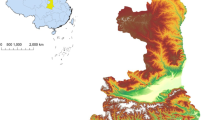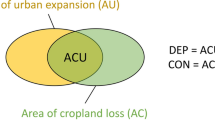Abstract
This article explores the factors and mechanism driving the land-use conversion at regional level by developing and using an econometric approach which is called the simultaneous equations model (SEM). A case study in Jiangxi Province of China is conducted by establishing the SEM, which consists of three equations including agricultural production, land conversion of cultivated land to built-up area and land conversion of cultivated land to forest cover/grassland from 1988 to 2005. And then this paper employs the method of piecewise estimation to represent the influences of the factors such as population, society, economy, location and geophysical conditions on the process of land-use conversion in Jiangxi Province. Estimation results show that population is a predominant factor driving the land-use conversion at counties, while social and economic factors are determinant factors in the short term for the entire Jiangxi Province. Specifically, the size of agricultural population and the magnitude of agricultural input determine the agricultural production to a large extent; population size, plain area proportion at counties and land management policies together affect the direction and magnitude of conversion between cultivated land and built-up area; agricultural population proportion, terrain slope, grain production and non-agricultural industry promote the conversion of cultivated land to forest cover/grassland. Furthermore, the explored mechanism also reveals the underlying causes of the land use changes driven by a series of factors in Jiangxi Province. Finally, this paper concludes that factors proven to play an important role in driving the land-use conversion need to be considered when the land management agencies make out the land use planning to optimize the land use, expand the agricultural production, and conserve the cultivated land.
Similar content being viewed by others
References
Amsalu, A, Stroosnijder, L, de Graaf, 2007. Long-term dynamics in land resource use and the driving forces in the Beressa watershed, highlands of Ethiopia. Journal of Environmental Management, 83: 448–459.
Bi Yuyun, Zheng Zhenyuan, 2000. The actual changes of cultivated area since the founding of new China. Resources Sciences, 22(2): 8–12. (in Chinese)
Carpenter S R, DeFries R, Dietz T et al., 2006. Millennium ecosystem assessment: Research needs. Science, 314(5797): 257–258.
Deng X, Huang J, Rozelle S et al., 2006. Cultivated land conversion and potential agricultural productivity in China. Land Use Policy, 23: 372–384.
Deng Xiangzheng, 2008a. Analysis of Land Use Conversion. Beijing: China Land Press. (in Chinese)
Deng Xiangzheng, 2008b. Simulation of Land System Dynamics. Beijing: China Land Press. (in Chinese)
Deng X, Huang J, Rozelle S et al., 2008a. Growth, population and industrialization and urban land expansion of China. Journal of Urban Economics, 63: 96–115.
Deng X, Su H, Zhan J, 2008b. Integration of multiple data sources to simulate the dynamics of land systems. Sensors, 8: 620–634.
Fu Bojie, Chen Liding, Wang Jun et al., 2003. Land use structure and ecological processes. Quaternary Sciences, 23(3): 247–255.
Hu Qi, Feng Song, Guo Hua et al., 2007. Interactions of the Yangtze River flow and hydrologic processes of the Poyang Lake, China. Journal of Hydrology, 347(1/2): 90–100.
Irwin E G, Bockstael N E, 2002. Interacting agents, spatial externalities, and the endogenous evolution of residential land use pattern. Journal of Economic Geography, 2(1): 31–54.
Lambin E F, Turner B L, Geist H J et al., 2001. The causes of land-use and land-cover change: Moving beyond the myths. Global Environmental Change, 11: 261–269.
Li Xiubin, 1999. Change of cultivated land area in china during the past 20 years and its policy implications. Journal of Natural Resources, 14(4): 329–333. (in Chinese)
Li Yuan, 2000. China Land Resources. Beijing: China Land Press. (in Chinese)
Liu J, Liu M, Tian H et al., 2005. Spatial and temporal patterns of China’s cropland during 1990–2000: An analysis based on Landsat TM data. Remote Sensing of Environment, 98: 442–456.
Liu Jiyuan, Zhan Jinyan, Deng Xiangzheng, 2005. Spatio-temporal patterns and driving forces of urban land expansion in China during the economic reform era. Ambio, 34(6): 450–455.
Long Hualou, Tang Guoping, Li Xiubin, 2007. Socio-economic driving forces of land-use change in Kunshan, the Yangtze River Delta economic area of China. Journal of Environmental Management, 83: 351–364.
Longley P A, 2002. Geography: Will development in urban remote sensing and GIS lead to better urban geography? Progress in Human Geography, 26(2): 231–239.
Mardiskis M G, Kalivas D P, Kollias V J, 2005. Comparison of interpolation methods for the prediction of reference evapotranspiration: An application in Greece. Water Resources Management, 2005, 19: 251–278.
Metzger M J, Rounsevell M D, Acosta-Michlik L et al., 2006. The vulnerability of ecosystem services to land use change. Agriculture, Ecosystems and Environment, 119: 69–85.
Ojima D S, Kittel T G T, Rosswall T et al., 1991. Critical issues for understanding global change effects on terrestrial ecosystems. Ecological Applications, 1: 316–325.
Rudel Thomas K, 2009. Tree farms: Driving forces and regional patterns in the global expansion of forest plantations. Land Use Policy, 26: 545–550.
Shoshany M, Goldshleger N, 2002. Land-use and population density changes in Israel-1950 to 1990: Analysis of regional and local trends. Land Use Policy, 19(2): 123–133.
Tan S K, 1999. Urban land use strategy targeted for dynamic equilibrium of cultivated land amount. Resources Sciences, 21(2): 24–29. (in Chinese)
Turner B L, Moss R H, Skole D L, 1993. Relating land use and global land-cover change: A proposal for an IGBP-HDP Core Project. IGBP Report No.24 and HDP Report No.5, 65pp.
Turner II B L, Skole D, Sanderson S et al., 1995. Land-Use and Land-Cover Change Science/Research Plan. IGBP Report No.35 and HDP Report No.7. IGBP, Stockholm.
Veldkamp A, Fresco L O, 1996. CLUE: A conceptual model to study the Conversion of Land Use and its Effects. Ecological Modelling, 85: 253–270.
Verburg P H, de Koning G H J, Kok K et al., 1999. A spatial explicit allocation procedure for modelling the pattern of land use change based upon actual land use. Ecological Modelling, 116: 45–61.
Wu G F, De Leeuw J, Skidmore A K et al., 2008. Comparison of MODIS and Landsat TM5 images for mapping tempo-spatial dynamics of Secchi disk depths in Poyang Lake National Nature Reserve, China. International Journal of Remote Sensing, 29(8): 2183–2198.
Author information
Authors and Affiliations
Corresponding author
Additional information
Foundation: National Natural Science Foundation of China, No.40801231; Knowledge Innovation Program of the CAS, No.KZCX2-YW-326-1; No.KZCX2-YW-305-2; No.KSCX1-YW-09-04; National Key Technology R&D Program of China, No.2006BAC08B03; No.2006BAC08B06
Author: Zhan Jinyan (1974–), Ph.D, specialized in ecosystem assessment and environmental informatics.
Rights and permissions
About this article
Cite this article
Zhan, J., Shi, N., He, S. et al. Factors and mechanism driving the land-use conversion in Jiangxi Province. J. Geogr. Sci. 20, 525–539 (2010). https://doi.org/10.1007/s11442-010-0525-y
Received:
Published:
Issue Date:
DOI: https://doi.org/10.1007/s11442-010-0525-y




